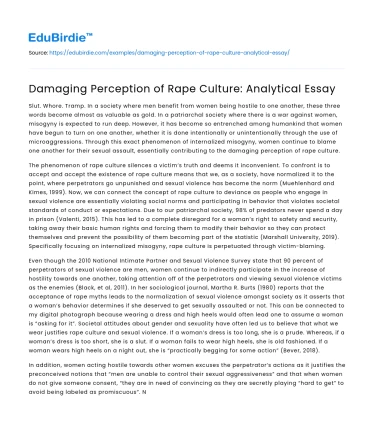Slut. Whore. Tramp. In a society where men benefit from women being hostile to one another, these three words become almost as valuable as gold. In a patriarchal society where there is a war against women, misogyny is expected to run deep. However, it has become so entrenched among humankind that women have begun to turn on one another, whether it is done intentionally or unintentionally through the use of microaggressions. Through this exact phenomenon of internalized misogyny, women continue to blame one another for their sexual assault, essentially contributing to the damaging perception of rape culture.
The phenomenon of rape culture silences a victim’s truth and deems it inconvenient. To confront is to accept and accept the existence of rape culture means that we, as a society, have normalized it to the point, where perpetrators go unpunished and sexual violence has become the norm (Muehlenhard and Kimes, 1999). Now, we can connect the concept of rape culture to deviance as people who engage in sexual violence are essentially violating social norms and participating in behavior that violates societal standards of conduct or expectations. Due to our patriarchal society, 98% of predators never spend a day in prison (Valenti, 2015). This has led to a complete disregard for a woman’s right to safety and security, taking away their basic human rights and forcing them to modify their behavior so they can protect themselves and prevent the possibility of them becoming part of the statistic (Marshall University, 2019). Specifically focusing on internalized misogyny, rape culture is perpetuated through victim-blaming.
Save your time!
We can take care of your essay
- Proper editing and formatting
- Free revision, title page, and bibliography
- Flexible prices and money-back guarantee
Even though the 2010 National Intimate Partner and Sexual Violence Survey state that 90 percent of perpetrators of sexual violence are men, women continue to indirectly participate in the increase of hostility towards one another, taking attention off of the perpetrators and viewing sexual violence victims as the enemies (Black, et al, 2011). In her sociological journal, Martha R. Burts (1980) reports that the acceptance of rape myths leads to the normalization of sexual violence amongst society as it asserts that a woman’s behavior determines if she deserved to get sexually assaulted or not. This can be connected to my digital photograph because wearing a dress and high heels would often lead one to assume a woman is “asking for it”. Societal attitudes about gender and sexuality have often led us to believe that what we wear justifies rape culture and sexual violence. If a woman’s dress is too long, she is a prude. Whereas, if a woman’s dress is too short, she is a slut. If a woman fails to wear high heels, she is old fashioned. If a woman wears high heels on a night out, she is “practically begging for some action” (Bever, 2018).
In addition, women acting hostile towards other women excuses the perpetrator’s actions as it justifies the preconceived notions that “men are unable to control their sexual aggressiveness” and that when women do not give someone consent, “they are in need of convincing as they are secretly playing “hard to get” to avoid being labeled as promiscuous”. Not only does this lead to the development of rape culture, but it also causes an increase in toxic masculinity, which refers to a sociological concept that glorifies dominance, violence, and aggression (Sculos, 2017).
After conducting several studies to prove the correlation between internalized misogyny and victim-blaming, Gloria Cowen, a Professor of Psychology at California State University San Bernardino, was able to report that when a woman displays malicious behavior towards another woman, it is likely she suffers from low self-esteem, resulting in her need to feel less hostile towards males in order to please her need for approval and validation. She indicates that some women might become more hostile due to their sudden distaste and wariness of other women. Some women tend to become more reliant on men for their emotional intelligence and dependence, preventing them from wanting to support victims. Instead, they begin to paint them in a negative light. Furthermore, when a woman lacks personal affection, support, and satisfaction in her life, she may choose to project her anger onto other women due to competitiveness or jealousy. Her studies essentially perpetuate rape culture as they state that when a woman feels as though she lacks something in her life that other women might have, she might feel much more accepted by the other sex. A woman might feel the need to come to a man’s defense when faced with sexual assault accusations. This is when victim-blaming arises as women choose to spread the blame on the victims rather than hold the perpetrators responsible (Cowan, 2000).
Although it is quite terrifying how society has conditioned a great number of women into blaming themselves instead of holding the actual predators accountable, we must recognize the women that continue to fight for social change. With social campaigns like the #MeToo Movement or the #TimesUp Movement, victims of sexual violence are being taken more seriously and perpetrators of sexual violence are being punished (MacKinnon, 2019). With people like Harvey Weinstein or Larry Nassar getting charged and sentenced with sexual assault charges, women are reclaiming the power that has been stripped away from them. With continuous protests and rallies taking place around the world, victims continue to share their stories, essentially pressuring the politicians in their countries to listen and create change that promotes equality.






 Stuck on your essay?
Stuck on your essay?

